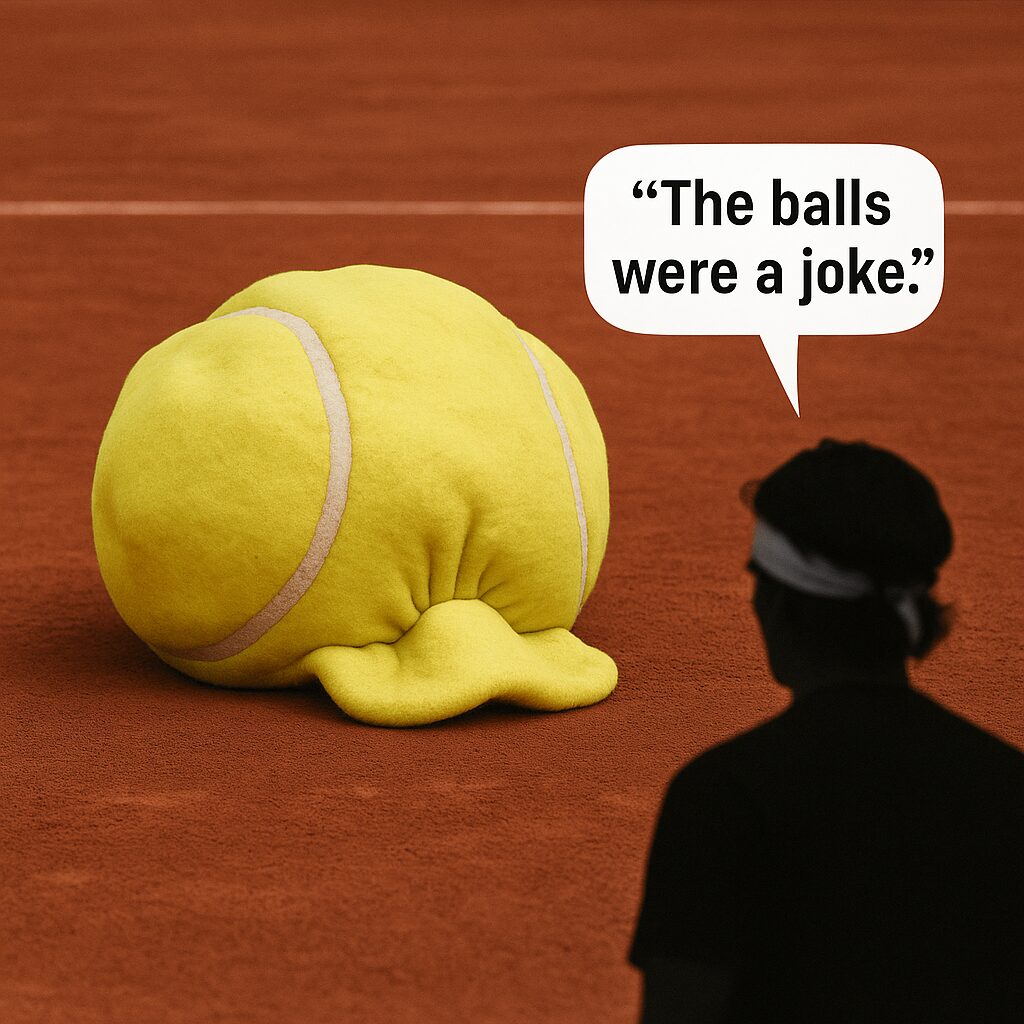When Alexander Zverev lost to Lorenzo Musetti at the 2024 Rome Masters, the story wasn’t just the scoreline—it was the tournament balls.
“The balls were a joke today… very big… very difficult to hit winners,” Zverev said post-match.
To the casual fan, that might sound like sour grapes. But to anyone paying attention, it was another shot fired in an ongoing onslaught of press conference comments about one of the sport’s most overlooked variables: the tennis ball.
Week after week, pros are being asked to adapt to completely different ball types. Each with its own feel, bounce, and behavior, all while competing at the highest level. And now, frustration is boiling over. Zverev isn’t alone. Players like Daniil Medvedev are calling out an inconsistency that’s silently shaping matches.
Not All Tennis Balls Are Created Equal
Professional tennis players don’t use the same balls week in and week out. In fact, every tournament often partners with a different brand, and that means players constantly adjust to new: felt textures, ball weights, sizes (yes, even within legal limits), and bounce behavior. These small adjustments have large effects, especially at the elite level.
The International Tennis Federation (ITF) sets specific standards: diameter between 2.57 and 2.70 inches, translating to a circumference of roughly 8.07 to 8.48 inches. But within that seemingly narrow range, there’s considerable room for brands to craft balls that feel firmer, fluffier, heavier, or livelier. This creates week-to-week variability that many players say disrupts consistency and rhythm.
ATP Tour: Pro Tennis Ball Brand Comparison
Let’s take a closer look at how top-tier balls differ in practice. Even if they all fall within ITF regulations, brands use unique materials and manufacturing processes. The result? Some balls stay compact and fast through a match. Others absorb moisture, expand, and get slow — often referred to as “getting big.”
Here’s a breakdown of how some popular pro balls compare:
Let’s take a closer look at how top-tier balls differ in practice. Even if they all fall within ITF regulations, brands use unique materials and manufacturing processes. The result? Some balls stay compact and fast through a match. Others absorb moisture, expand, and get slow — often referred to as “getting big.”
Here’s a breakdown of how some popular pro balls compare:
| Brand | Circumference (inches) | Court Suitability | Tour Use |
|---|---|---|---|
| Wilson US Open | ~8.25 | Hard courts | US Open, WTA/ATP hard events |
| Dunlop ATP | ~8.20–8.35 | All surfaces | Rome, Australian Open |
| Penn Tour | ~8.23–8.30 | Hard/clay | USTA Pro Circuit |
| Babolat Gold | ~8.15–8.30 | Clay | Formerly Roland-Garros |
| Slazenger | ~8.25 | Grass | Wimbledon |
| Tecnifibre X-One | ~8.20–8.32 | All surfaces | ATP Challengers, ITF events |
The difference between an 8.20″ and 8.35″ circumference may seem small, but over the course of long rallies, it can completely change how much control and spin a player can generate. And when conditions are humid or damp, that felt absorbs more water, making the ball heavier and harder to hit through.
So, What’s the Big Deal?
Zverev explained it clearly: “The ball is very, very big. It’s very difficult to hit winners… They say we play with the same ball in Monaco, Madrid, Munich. Then we come here and the ball is totally different.”
This isn’t just semantics. There’s a reason new balls are brought in—they get worn down and don’t pop.
First change: After the first 7 games (accounts for pre-match warm-up).
Subsequent changes: Every 9 games (7, 16, 25, etc.).
A ball that “gets big” over a match affects everything from timing and footwork to shoulder fatigue. When the ball feels heavier, players must swing harder to generate pace, which can lead to injury over a long season. The bounce height also changes, forcing players to constantly recalibrate their strike zones.
For attacking players like Zverev, this is especially frustrating. Their games are built around first-strike tennis, quick points, and aggressive hitting. Heavy, slow balls neutralize those strengths. Instead of dictating rallies, they end up grinding from the baseline.
Style Matchups & Ball Impact
Lorenzo Musetti’s game couldn’t be more different from Zverev’s. He plays with heavy topspin, a beautiful one-handed backhand, and thrives in long, drawn-out exchanges. His style benefits from slower conditions that give him more time to set up and frustrate opponents.
On fast courts with low-fluff balls, Musetti can be rushed. But on heavy clay with slower Dunlop balls, his defensive skills shine. He gets to more balls, produces more spin, and forces his opponent into uncomfortable positions. Zverev’s power was blunted, and Musetti turned the tables.
This is a clear example of how different ball brands and conditions don’t just influence performance — they shape the entire dynamic of a match. What might look like a simple gear difference can mean a matchup advantage for one player and a nightmare for another.
Should Pro Tennis Standardize Balls?
More players are speaking out, and the debate is growing louder. Some argue that the variety adds to tennis’s charm. Different balls for different surfaces can highlight new skills and challenge players to adapt. But others say the pendulum has swung too far, and week-to-week inconsistency has become a physical and tactical burden.
Standardizing balls across the ATP and WTA Tours could improve fairness and reduce injury risk. It would also simplify training and preparation. But it might also reduce the unique feel of each event. Tournaments pride themselves on tradition, including ball selection. The question remains: do we prioritize player consistency or preserve surface-specific identity?
One thing is clear: tennis balls are no longer just equipment. They’re a competitive factor, a health issue, and a growing part of the pro tennis conversation. If Zverev’s rant in Rome starts a broader movement, we could see some changes coming.

